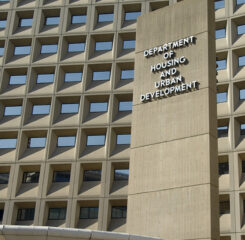In response to continued advocacy by LeadingAge and others, the Department of Housing and Urban Development (HUD) has published a Request for Information (RFI) seeking public input on insurance coverage issues and opportunities.
Specifically, HUD is requesting input on increasing the resilience of residential properties to natural hazards and extreme weather, which will allow the agency to develop policies that better support housing providers in addressing climate resilience and accessing affordable insurance for their properties.
“Currently, some affordable housing properties faced with suddenly higher insurance costs report that they are coming in short-term ways, including reducing insurance coverage or cutting back on provider services,” reads the RFI, echoing LeadingAge’s recent comments to HUD on the issue. “Owners and PHAs [Public Housing Authorities] have also reported that they may have to resort to relaying capital repairs or consider the sale of properties…Additionally, financing deals for the development of new properties are becoming more difficult to pencil out or close.”
The RFI asks seven questions specifically of single and multifamily housing providers, followed by additional questions targeted at tribal communities and manufactured housing. The questions focus on financial savings resulting from risk mitigation, incentives for resilience elements at properties, and data availability for long-term adjustments, as well as successful state and local resilience measures.
- Question for comment #1: What are the financial savings ( e.g., insurance premiums or avoided casualty loss) and other benefits associated with modifications to existing single family or multifamily properties, including public housing, to mitigate damage from natural hazards or increase resilience in the event of a natural hazard? How do these savings compare to the costs associated with those modifications? Please list modifications and each of their damage mitigation benefits as well as financial and time costs. Distinguish by peril type (earthquake, hurricane, floods, hail, drought, wildfire, extreme heat, landslide, etc.) or geography as appropriate, as well as by building and construction type.
- Question for comment #2: What are the financial savings ( e.g., insurance premiums or avoided casualty loss) and other benefits associated with building new construction properties with building and design features that mitigate damage from natural hazards or increase resilience in the event of a natural hazard? How do these savings compare to the costs associated with those features? Please list building and design features and each of their damage mitigation benefits as well as financial and time costs. Distinguish by peril type (earthquake, hurricane, floods, hail, drought, wildfire, extreme heat, landslide, etc.) or geography as appropriate, as well as by building and construction type.
- Question for comment #3: What data exist around the additional time or financial costs, if any, of rebuilding to or above code post-disaster instead of waiving requirements? Is there information on the longer-term costs ( e.g., financial or damage-related) related to waiving building requirements when rebuilding post-disaster?
- Question for comment #4: Are there local or state statutes, regulations, or incentives that help property owners reduce costs or save on expenses, including insurance costs, when they invest in resilience ( e.g., reduced insurance premiums, tax abatements, subsidies/discounts)? If possible, please provide data on how successful these measures have been in saving on expenses.
- Question for comment #5: Please identify any industry standards related to resilience that you have used or referenced in your work. If possible, please document where the standard has been applied, at what scale, and to what effect.
- Question for comment #6: Are there local, state, or regional outreach or education efforts that have been successful in helping homeowners and housing providers understand the direct and indirect benefits of investing in resilience measures?
- Question for comment #7: What data would be useful for insurers (including risk pools) and reinsurers on efforts to mitigate damage from natural hazards or increase resilience to natural hazards, such as housing elevations, home resilience upgrades, and infrastructure improvements?
The RFI follows a recent effort by HUD to better reflect insurance cost increases in Operating Cost Adjustment Factor (OCAF) calculations, which are annual budget increases for certain HUD-assisted properties.
LeadingAge applauds HUD for acknowledging the severe increases in insurance costs and the lack of insurance availability for HUD-assisted housing communities, and we will work with members to submit comments by the February 28 deadline.
Reach out to Juliana Bilowich (jbilowich@leadingage.org), LeadingAge’s Director of Housing Operations and Policy, to join the effort.

 Shutdown Week Three: Impact of Ongoing Closure on Affordable Housing
Shutdown Week Three: Impact of Ongoing Closure on Affordable Housing


